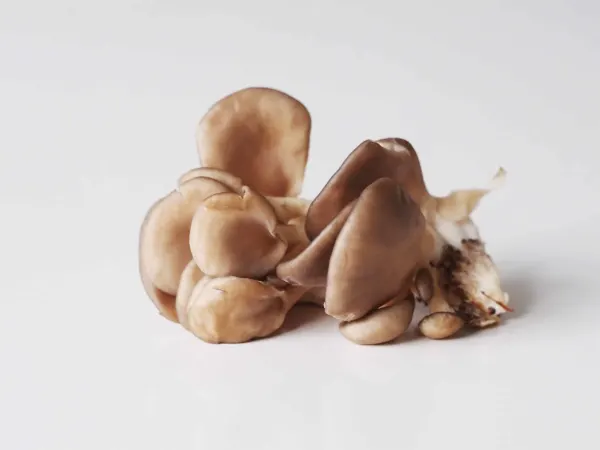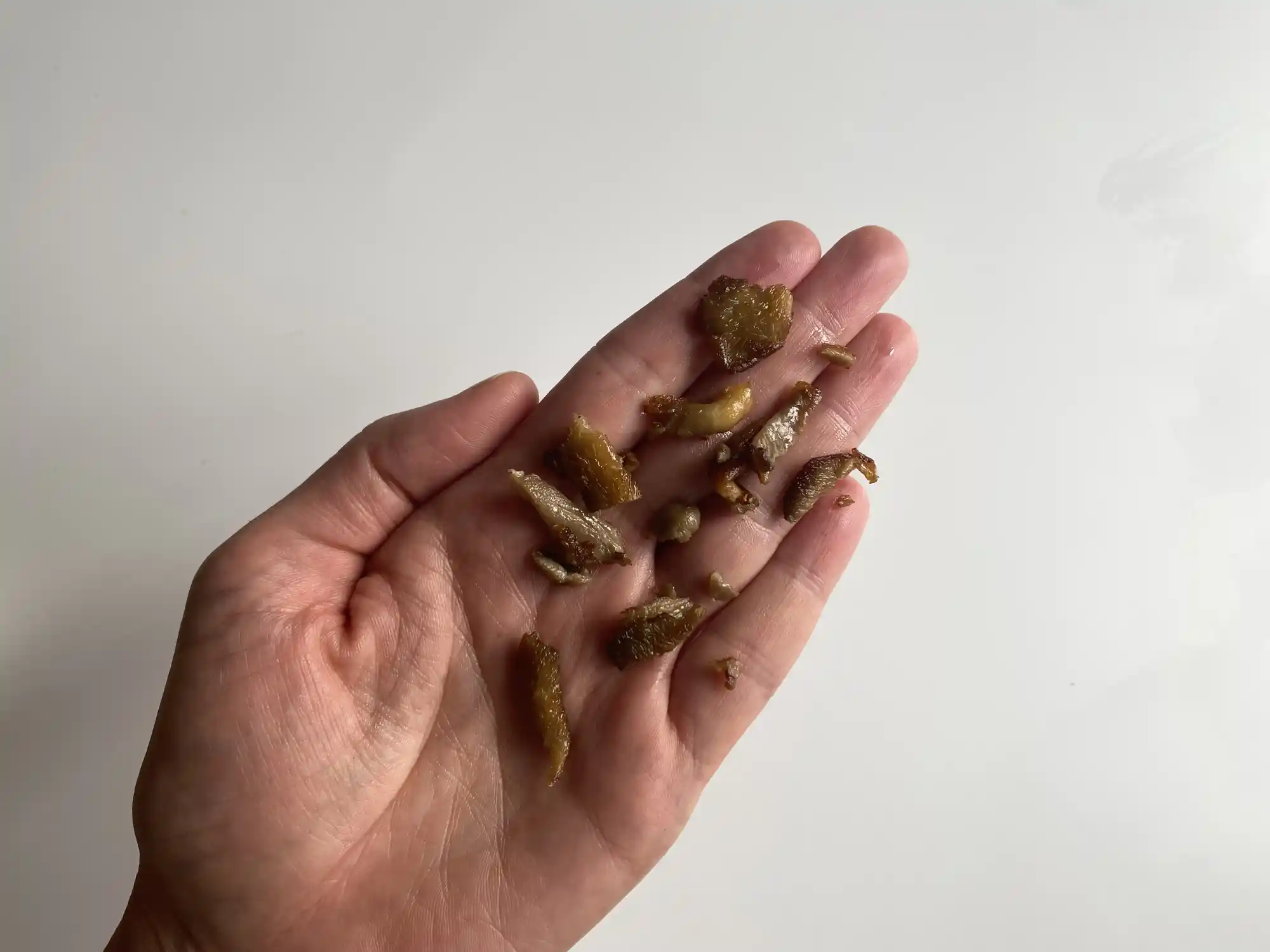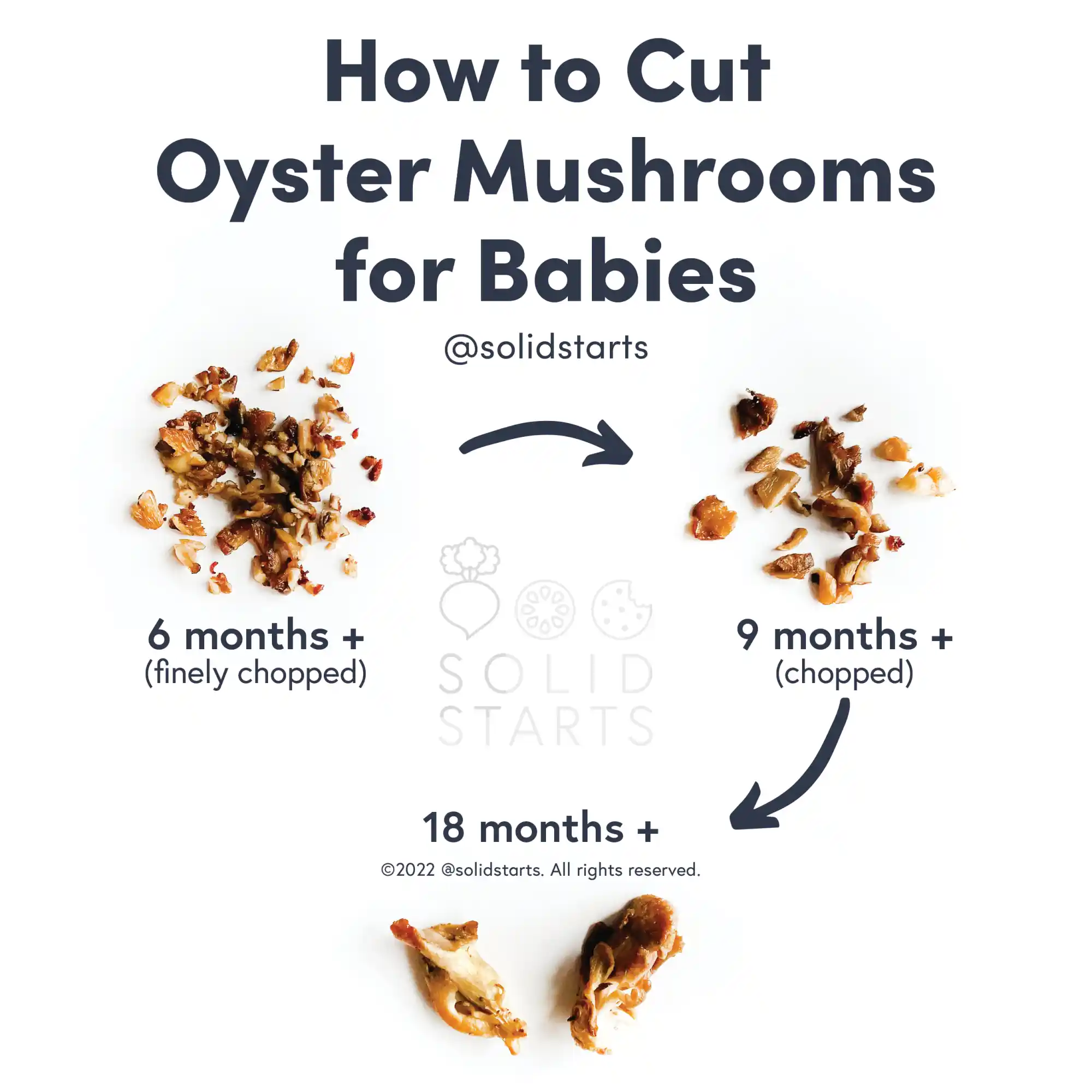Acceda a la base de datos First Foods® en Solid Starts App.
Leer másChampiñón Ostra
Hongo
Sugerencia de edades
6 meses
Alto contenido de hierro
No
Alérgeno común
No

When can babies eat oyster mushrooms?
¡Lo sentimos, esta página aún no está disponible en español! Estamos trabajando tan rápido como podemos para traducir todo nuestro contenido, gracias por tu paciencia y apoyo.
Babies may be introduced to edible mushrooms as soon as they are ready to start solids, which is generally around 6 months of age.
How do you prepare oyster mushrooms for babies with baby-led weaning?
Cada bebé se desarrolla a su propio ritmo, y las sugerencias que ofrecemos sobre cómo cortar o preparar determinados alimentos son generalizaciones para una amplia audiencia.
6 months old+:
Mix finely chopped, cooked oyster mushrooms into foods that are easy for baby to pick up or scoop, such as congee, egg strips, mashed vegetables, or porridge.
9 months old+:
Serve bite-sized pieces of cooked oyster mushrooms on their own, or as part of a meal. You can also mix finely chopped and cooked oyster mushrooms into soft foods for the child to practice scooping.
12 months old+:
Serve bite-sized pieces of cooked oyster mushrooms on their own, or as part of a meal. You can also mix finely chopped and cooked oyster mushrooms into soft foods for the child to practice scooping.
18 months old+:
Offer chopped, cooked oyster mushrooms as desired, on their own or as part of a meal. At this age, if the child has mature eating skills (not overstuffing their mouth, chewing food thoroughly before swallowing, etc.), you can try moving back up in size to larger pieces or whole cooked oyster mushrooms for biting and tearing practice.

Expand baby’s palate with recipes from around the world with our 100 Dinners for Babies & Toddlers guide.
Videos
Are oyster mushrooms a common choking hazard for babies?
Yes. Mushrooms can be chewy and challenging for new eaters to break down in their mouths. To reduce the risk, finely chop and fully cook the mushrooms. Dried mushrooms should be fully rehydrated in boiling water and chopped before serving. As always, be sure to create a safe eating environment and stay within arm’s reach of baby during mealtime. For more information, visit our section on gagging and choking and familiarize yourself with common choking hazards.
Are oyster mushrooms a common allergen?
No. Mushroom allergy is rare, although not unheard of. There have been reports of anaphylaxis, as well as rashes among those handling mushrooms. Mushrooms also contain chitin, a common carbohydrate found in crustaceans and insects that may contribute to an allergic response in certain individuals.
Individuals with Oral Allergy Syndrome (also called pollen food allergy syndrome), particularly those with sensitivity to mold, may also be sensitive to mushrooms. Oral Allergy Syndrome typically results in short-lived itching in the mouth and is unlikely to result in a dangerous reaction. Cooking mushrooms can help minimize and even eliminate the reaction.
Dried oyster mushrooms may be preserved with sulfites. While sulfites are not a common allergen, certain individuals, particularly those with asthma, can have allergy-like reactions to added sulfites. If sulfites are a concern, avoid ingredients such as sulfur dioxide, potassium bisulfate, potassium metabisulfite, sodium bisulfite, sodium metabisulfite, and sodium sulfite to name a few.
As you would when introducing any new food, start by offering a small quantity for the first few servings. If there is no adverse reaction, gradually increase the amount over future meals.
Are oyster mushrooms healthy for babies?
Yes. Oyster mushrooms are rich in choline, folate, zinc, vitamin B6, and fiber. These nutrients work together to support baby’s neurodevelopment, cellular health, metabolism, taste and smell perception, immune function, and digestive function. Plus, oyster mushrooms also may have anti-cancer and immune-supporting properties.
Make sure to buy oyster mushrooms from a reputable source and avoid foraging your own mushrooms unless you are an expert mycologist, as there are many poisonous mushrooms growing in the wild.
Can oyster mushrooms help babies poop?
Yes. Oyster mushrooms are rich in fiber and fluid to support healthy gut bacteria, bulk up poop, and hydrate the intestines. Mushrooms also offer prebiotics, special carbohydrates that help friendly gut bacteria flourish. Introduce high-fiber foods like mushrooms gradually and regularly in baby’s diet as tolerated; a little gassiness or a few blowouts is just a sign that baby’s digestive system is adjusting, so no need to remove the food from the diet. Remember that pooping patterns can vary significantly from baby to baby. If you have concerns about baby’s pooping and digestive function, talk to your pediatric healthcare provider.
Where do oyster mushrooms come from?
Oyster mushrooms grow on decaying trees in temperate forests across the globe, though they are also one of the most widely cultivated mushrooms, particularly popular throughout Asia, where they are known as dhingri, neutari-beoseot, andpíng gū, among many other names. Lore suggests that the oyster mushroom gets its name in English from its shell-shaped cap and the steely grey color of one of the most widely available varieties. There are actually more than 200 species of oyster mushrooms that range in both muted and vivid colors, from pale cream and snowy white, to bright pink and sunny yellow.
Can babies eat raw oyster mushrooms?
Yes, although cooked oyster mushrooms are easier for baby to digest. Cooking mushrooms also helps lower the risk of foodborne illness.
Nuestro equipo
Escrito por
Consejos de expertos directo a tu bandeja de entrada
¡Suscríbete y recibe correos semanales con recetas, consejos y más!
Copyright © 2025 • Solid Starts Inc









